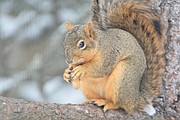Fox squirrel: A red-coated, bird feeder bandit!
Don Bartling Contributing Writer | Hagadone News Network | UPDATED 6 years, 9 months AGO
“Advice from a squirrel: Plan ahead, stay active, spend time in the woods, go out on a limb and its OK to be a little nuts!!”
As I watched the red-coated bird seed bandit leave the feeder to go back to his home, I was amazed how he would climb from branch to branch and leap from tree to tree almost effortlessly.
Fox squirrels are impressive jumpers and can make jumps spanning 15 feet in horizontal leaps, and free-falling 20 feet or more to a soft landing on a limb or trunk.
Squirrels can be busy little fellas, living out their lives running around gathering and hoarding food, mating and raising young. During the snowstorm last weekend I watched a busy fox squirrel as he raided the suet block at our bird feeder. He would quickly eat, hesitate, look around to see if there were any intruders, and then continue with his feast.
The fox squirrel is named for its gray and red colored fur that resembles the pelt of a fox. He make three kinds of houses: cozy den nests in hollows of over-mature trees with holes from rot or woodpeckers; comfy winter dreys (nests); and summer dreys. Den trees when available are used in the winter and are the preferred shelter because the survival rate for squirrel pups is higher in tree dens compared to leaf nests.
Due to lack of access in some areas where the den trees aren’t available, the fox squirrel must make winter dreys for the raising of their young. About 30 feet up, at a major fork in the tree, they build a roughly ball-shaped structure over a foot or two in diameter with one entrance. The watertight outside is composed of twigs, pine needles, or leaves. The inside cavity is six to eight inches in diameter and can be lined with feathers, fur, grass, leaves, moss, shredded bark, etc. — any organic material that adds insulation. Trees selected are usually close together as part of a windbreak, safe travel to other trees and to give easy exit in case of predators.
Summer dreys are also located in the upper third of mature trees about 30 feet up, but are not so elaborate in construction. Sometimes they’re just open platforms used for resting or eating.
The fox squirrel is the largest (2–3 pounds weight, 18–29 inches length) tree squirrel in North America and has short, rounded ears. It has a stubby neck as compared to the gray squirrel. A fox squirrel’s tail is long, very bushy, and has yellow tips on its tail hairs.
The tail can be used for a variety of functions: it can be wrapped around the squirrel for warmth, used as an aid for balance, or spread and used as a parachute. The tail is also used to communicate with other squirrels; it can indicate being playful or when exhibiting quick, jerky movements demonstrates nervousness or excitement.
A fox squirrel’s range can be 10 to 40 acres and with overlapping territories of different squirrels. They sometimes share stores and nests in winter. Their main diet consists of leftover mast or pine nuts in the spring, seeds of elms, maple, and pine in the summer, and acorns in the fall and winter, but they will also eat berries, bird eggs, bulbs, buds, certain flowers, frogs, fruit, green shoots, inner bark, insects, mushrooms, nuts, roots, seeds, and vegetables. A fox squirrel may drink water on occasion but the majority of moisture they receive is through succulent plants that they eat.
When acorns or pine nuts are available, fox squirrels are very busy harvesting as many as they can find and storing them by burying them in the ground. Many acorns and nuts are infested with bugs and will not store well. These infested seeds are detected by the squirrel’s keen sense of smell and thrown away or eaten right away. The ones that are clear of bugs are selected for storage.
The squirrel will clean the seed by licking it or rubbing it against its face, which also places a smell from its scent glands on the seed. After picking a spot they dig a hole with their front paws, push the one to three seeds in, and quickly cover it up. Later for a meal in the winter the squirrel will locate them even through the snow using their keen nose.
They are not particularly gregarious or playful — in fact they have been described as solitary and anti-social creatures, coming together only in breeding season. They have a large vocabulary, consisting most notably of an assortment of clucking and chucking sounds, not unlike some “game” birds, and they warn the listening world of approaching threats with distress screams. In the spring and fall, groups of fox squirrels clucking and chucking together can make a small ruckus. When threatening another fox squirrel, they will stand upright with their tail over their back and flick it.
The maximum life expectancy is typically 12 years for the female and eight years for the males. Relatively few natural predators can regularly capture adult fox squirrels. Of these predators, most only take fox squirrels opportunistically. Fox squirrel predators include: bobcats, foxes, red-tailed hawks, great horned owls, and dogs.
Discover Boundary County wildlife. Enjoy the outdoors!
ARTICLES BY DON BARTLING CONTRIBUTING WRITER

About the Douglas fir
“The big tree is nature’s forest masterpiece, and so far as I know, the greatest of living things.” — John Muir 1838-1914 “Father of the National Parks” and author.

Winter on the hoof: How deer, elk and moose cope with the snow!
“When snow falls, nature listens.”




